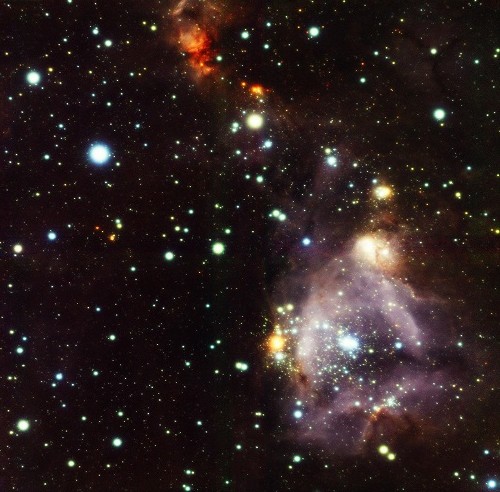- Date: 29 Jun 2016
- Comments: (0)
- Categories: For Everyone, Human Interest
Capturing “Shocking” Young Stars in N159W
The world’s most advanced adaptive optics system reveals “shocking” details on star formation in a new image released by the Gemini Observatory. Benoit Neichel of the Laboratoire d’Astrophysique de Marseille, worked with PhD student Anaïs Bernard on the research behind the image. Bernard came to Gemini South with Neichel as part of Gemini’s Bring One, Get One program, and plans to complete her PhD based on this work in 2017.
Bernard’s trip to Gemini was her first experience at a large telescope facility.
“I was impressed by the laser guide stars propagating in the direction of the Large Magellanic Cloud (LMC), pointing to the field that we had carefully selected in the previous months,” says Bernard.
Perfect Conditions
Gemini systems were performing well, but the seeing conditions for the first three nights of their run weren’t great. Bernard said she and Neichel were anxious at the beginning of their observing night, but the sky was extremely clear. That particular night happened to be the best of the run, and they were lucky enough to capture N159W in the LMC with the Gemini Multi-object Spectrograph (GeMS) lasers and the Gemini South Adaptive Optics Imager (GSAOI) right from the first part of the night. Bernard emphasizes that those data represent a major step in her PhD program. She spent months selecting targets and adjusting all the observation parameters, learning how to position the field, where to take the background image, which star should be used for the photometric calibration.
“I was impressed to see that everything ran exactly according to our plan, and the results came out even better than what I would have expected!”

Gemini South GeMS/GSAOI near-infrared image of the N159W field in the Large Magellanic Cloud. The image spans 1.5 arcminutes across, resolves stars to about 0.09 arcseconds, and is a composite of three filters (J, H, and Ks).
Data Analysis
Apart from the scientific analysis of the data, Bernard also used the images to develop new data reduction tools.
“Those images are also the key data set that we are using to define and test new data reduction tools. As the level of details and the large field provided by GeMS/GSAOI are unique, new data reduction and analysis tools must be developed. This is also exciting because even once we are back in our office, far from the telescope, we can still significantly improve the quality of those sharp images, and optimize the scientific return of the instrument.”






